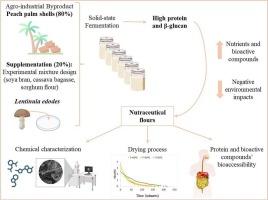Agro-industrial waste valorization through solid-state fermentation by Lentinula edodes for high-protein and β-glucans flour development for human diet: Chemical characterization, drying kinetics evaluation, and bioaccessibility
Q1 Environmental Science
引用次数: 0
Abstract
This study aimed to develop a high-protein and β-glucans flour for the human diet through the solid-state fermentation of peach palm shells by Lentinula edodes. Six biomasses were produced to analyze the effects of cultivation substrate on the physicochemical properties, using soya bran, cassava bagasse, and sorghum flour as supplements. The biomasses that presented the highest protein and β-glucans content were analyzed to obtain the drying kinetics behavior and the in vitro digestibility. Two flours presented the highest protein content (28.32 g 100 g−1) and the highest β-glucans content (9.44 g 100 g−1), high minerals and dietary fiber content and low lipid content, and high bioaccessibility of protein (23.72–25.17 %) and bioactive compounds (76.69–77.66 mg EAG/100 g). Therefore, it is possible to obtain high-quality flours for human consumption through a biotechnological process, being a source of nutrients and bioactive compounds, helping to reduce the negative environmental impacts generated in the heart of palm industrialization, promoting the circular bioeconomy and supporting the UN's sustainable development goals.

通过香菇固态发酵生产高蛋白和β-葡聚糖的农用工业废物的增值:化学特性、干燥动力学评价和生物可及性
本研究旨在利用香菇固态发酵桃棕榈壳,开发一种高蛋白、β-葡聚糖的人类膳食面粉。以大豆麸皮、木薯甘蔗渣和高粱粉为补充物,制备了6种生物质,分析了栽培基质对其理化性质的影响。对蛋白质和β-葡聚糖含量最高的生物质进行了干燥动力学行为和体外消化率分析。两种面粉的蛋白质含量最高(28.32 g 100 g−1),β-葡聚糖含量最高(9.44 g 100 g−1),矿物质和膳食纤维含量高,脂肪含量低,蛋白质的生物可及性高(23.72 ~ 25.17%),生物活性物质含量高(76.69 ~ 77.66 mg EAG/100 g)。因此,有可能通过生物技术过程获得供人类消费的高质量面粉,作为营养素和生物活性化合物的来源,有助于减少棕榈工业化核心产生的负面环境影响,促进循环生物经济并支持联合国的可持续发展目标。
本文章由计算机程序翻译,如有差异,请以英文原文为准。
求助全文
约1分钟内获得全文
求助全文
来源期刊

Bioresource Technology Reports
Environmental Science-Environmental Engineering
CiteScore
7.20
自引率
0.00%
发文量
390
审稿时长
28 days
 求助内容:
求助内容: 应助结果提醒方式:
应助结果提醒方式:


